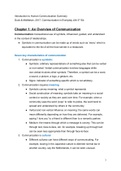Introduction to Human Communication Summary
Duck & McMahan, 2017, Communication in Everyday Life 3rd Ed.
Chapter 1: An Overview of Communication
Communication: transactional use of symbols, influenced, guided, and understood
in the context of relationships.
● Symbols in communication can be made up of words such as ‘menu’ which is
equivalent to the list of all the food served in a restaurant.
Seven key characteristics of communication
1. Communication is symbolic
● Symbols: arbitrary representations of something else that can be verbal
or non-verbal. Verbal communication involves languages while
non-verbal involves other symbols. Therefore, a symbol can be a word,
a sound, a picture, a logo, a gesture, etc.
● Signs: indicator of something specific which is not arbitrary.
2. Communication requires meaning
● Symbols convey meaning: what a symbol represents
● Social construction of meaning: symbols take on meaning in a social
context or society as they are used over time. For example, when a
community uses the word ‘popo’ to refer to police, the word tend to
spread and understood by others in the community.
● Verbal and non-verbal influence on meaning: the same words can
mean differently depending on how they are delivered. For example,
saying ‘I love you’ to a friend is different than to a romantic partner.
● Medium: the means through which a message is convey. This can be
through text, face-to-face, etc. for example, breaking up through text
can be seen less appropriate than through face-to-face
3. Communication is cultural
● Different cultures can have different ways of communicating. For
example, bowing in the Japanese culture is deemed normal but in
another country, say the Netherlands, it can be seen unusual.
1
, ● Different cultures make different assumptions and take different
knowledge
4. Communication is relational
● Communication affects relationships and relationships affect
communication. Relational cues within communication enable people to
determine. For example, yelling “come into my office now!” can indicate a
status difference between a boss and an employee through the
communication style
5. Communication involves frames
● Frames: basic forms of knowledge that provide a definition of a scenario
either because both people agree on the nature of the situation or the
cultural assumption built into the interaction and the previous relational
context of talk give them a clue.
● Communication frame: draws boundary around a conversation and pulls
our attention toward certain things and away from others
● In other words: how something is presented to the audience influences the
choices people make about the way to process the information
● Coordinating interactions: Frames help people understand their roles in a
conversation and what is expected of them. For example, being an
interview lets you know that the interviewer will be asking questions and
you are expected to answer.
● Assigning meanings: assigning meanings to symbols and deciding on how
to interpret the symbols. For example, when talking to a friend in a room
full of people there may be terms unfamiliar to other people.
● Perspectives: communication frames are based on a person’s perspective
of situations and relationships with others. Frame of reference:
communication based on previous experience and conversation.
6. Communication is a transaction
● Communication message transacts something and is more than just
symbols being exchanged. For example, when people touch one
another then love is realized (transaction)
● Action: when a sender send a message to the receiver
● Interaction: when the receiver send back a message to the sender
(exchanging messages)
2
, ● Transaction: when messages are exchanged simultaneously which
develop a meaning/value
7. Communication is both presentational and representational
● Representation: describes facts or conveys information
● Presentation: based on one person’s POV
● Your selection of words also represent your view of the world to others.
For example, when a friend asks why you cheated you would choose
words wisely in order for the friend to view the situation from your
perspective.
● Thus, your message is conveying information (representational) while
providing a glimpse into your perspective and how you want your friend
to view the situation (presentational).
In conclusion: communication doesn’t only construct meanings but create
relationships, cultures, ethnicities, sexualities, realities, etc. by maintaining,
negotiating, challenging that are altered through communication.
Tutorial 7/9/21
● A change in communication is possible and depends if the person wants to or
not. For example, old people from another era might have to change and
adapt to the new meanings in communication symbols
● Case: if someone is homophobic, someone else tells them that they are
ignorant but what does ignorant means and why ignorant?
Live Lecture 6/9/21
● Case: 9/11 attack was an act of communication as the terrorists used the
symbolic nature of WTC to deliver a message “we can hit you hard in your
homeland”. This is a communication because Al-Qaeda needed an audience
to witness their attack. As for the public, the symbolic meaning of WTC will
change and forever be remembered as the 9/11 tower attack. Al-Qaeda might
have anticipated the next step in transaction as President Bush declared war
on terror.
● Major differences between the approaches:
● Social scientific approach: explaining / solves problem by objectification
and quantification.
3
, ● Interpretative approach: understanding / not possible to solve because
everything humans learn or know is influenced by human experiences
● Critical approach: raising criticism
● The philosophy of empiricism (17th century): empiricists answer what is called
the epistemological question “what provided the basis of our knowledge?”
which answers to “the world that surrounds us is the basis of knowledge
(empirical reality)”.
● Empiricism: the reality is based on our sense data or in other words, what we
know is based on what we see, hear, smell, taste, and feel.
4






